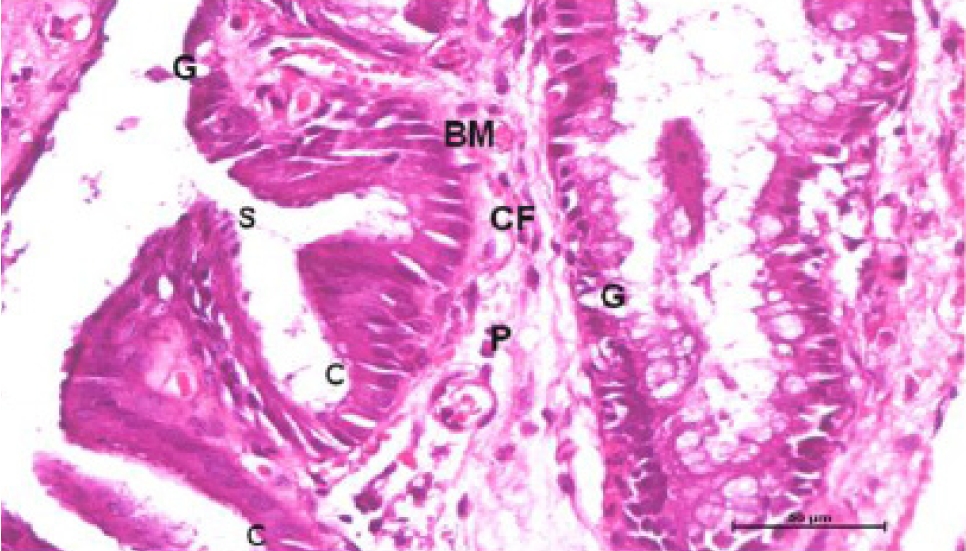The impact of intracervical hyaluronidase enzyme on cervical histomorphology in successfully detorted uterine torsion affected buffaloes
DOI:
https://doi.org/10.56825/bufbu.2023.4233577Keywords:
Bubalus bubalis, buffaloes, cervix, histomorphology, hyaluronidase, uterine torsionAbstract
The present study evaluated the impact of intracervical hyaluronidase enzyme on cervical histomorphology in successfully detorted uterine torsion affected buffaloes. These animals were either subjected to routine post-detorsion treatment (n=10) or in addition to routine treatment, hyaluronidase enzyme (10,000 IU; 2.5 ml at each of 3, 6, 9, 12 o’clock position of cervix) was administered intracervically immediately post-detorsion (n=10), followed by repeated administration at 6 h interval (0, 6, 12, 18 h) till complete cervical dilatation or till 24 h after detorsion. The pre-treatment cervical biopsy samples were collected immediately after detorsion and post-treatment samples were collected at complete cervical dilatation which happened within 24 h after detorsion in all the cases. Following histomorphology, the quantification of collagen fibers as mean percentage area occupied collagen out of total tissue area in pre-treatment cervical biopsy samples of all the buffaloes was revealed as 21.0±5.7. During post-treatment period, at the time of complete cervical dilatation, this value exhibited a decrease in control (9.1±2.2; P>0.05) as well as hyaluronidase group (5.8±2.1; P<0.05). In summary, collagen fiber dispersion in cervical tissue of successfully detorted uterine torsion affected buffaloes suggested their role in cervical dilatation, whereby, intracervical hyaluronidase was able to enhance the cervical tissue collagen dispersion.
Downloads
Metrics
References
Dowthwaite, G.P., A.C. Ward, J. Flannely, R.F.L. Suswillo, C.R. Flannery, C.W. Archer and A.A. Pitsillides. 1999. The effect of mechanical strain on hyaluronan metabolism in embryonic fibrocartilage cells. Matrix Biol., 18(6): 523-532. DOI: 10.1016/s0945-053x(99)00044-x
El-Maradny, E., N. Kanayama, H. Kobayashi, B. Hossain, S. Khatun, S. Liping, T. Kobyashi and T. Terao. 1997. The role of hyaluronic acid as a mediator and regulator of cervical ripening. Hum. Reprod., 12(5): 1080-1088. DOI: 10.1093/humrep/12.5.1080
Ghuman, S.P.S. 2010. Uterine torsion in bovines: A review. Indian J. Anim. Sci., 80(4): 289-305.
Honparkhe, M., S.P.S. Ghuman, A. Kumar, N.K. Sood, K. Gupta and C.S. Ahuja. 2009. Cervical massage with sodium carboxy methyl cellulose for achieving complete cervical dilatation in successfully detorted uterine torsion affected buffaloes. Indian J. Anim. Sci., 79(1): 26-29.
Kobayashi, H. and T. Terao. 1997. Hyaluronic acid-specific regulation of cytokines by human uterine fibroblasts. Am. J. Physiol., 273(4): 151-159. DOI: 10.1152/ajpcell.1997.273.4.C1151
Li, W., Z. Li and K.W. Ha. 1994. Effect of hyaluronidase on cervical ripening. Chinese Med. J-peking, 107(7): 552-553.
Luna, L.G. 1968. Manual of Histologic Staining Methods of the Armed Forces Institute of Pathology, 3rd ed. McGraw-Hill Book Company, Blakiston Division, New York, USA. p. 165.
Nagase, H. and J.F.Jr. Woessner. 1999. Matrix metalloproteinase. J. Biol. Chem., 274(31): 21491-21494. DOI: 10.1074/jbc.274.31.21491
Obara, M., H. Hirano, M. Ogawa, H. Tsubaki, N. Hosoya, Y. Yoshida, S. Miyauchi and T. Tanaka. 2001. Changes in molecular weight of hyaluronan and hyaluronidase activity in uterine cervical mucus in cervical ripening. Acta Obstet. Gyn. Scan., 80(6): 492-496. DOI: 10.1034/j.1600-0412.2001.080006492.x
Purohit, G.N., P. Kumar, K. Solanki, C. Shekher and S.P. Yadav. 2012. Perspectives of fetal dystocia in cattle and buffalo. Veterinary Science Development, 2(1): 31-42. DOI: 10.4081/vsd.2012.3712
Singh, N. 2018. Doppler sonography as prognostic indicator in uterine torsion affected buffaloes. Ph.D. Dissertation, Guru Angad Dev Veterinary and Animal Sciences University, Ludhiana, India.
Uchiyama, T., T. Sakuta and T. Kanayama. 2005. Regulation of hyaluronan synthases in mouse uterine cervix. Biochem. Biophy. Res. Comm., 327(3): 927-932. DOI: 10.1016/j.bbrc.2004.12.092
Winkler, M., A. Oberpichler, H. Tschesche, P. Ruck, D.C. Fischer and W. Rath. 1999. Collagenolysis in the lower uterine segment during parturition at term: correlations with stage of cervical dilatation and duration of labor. Am. J. Obstet. Gynecol., 181(1): 153-158. DOI: 10.1016/s0002-9378(99)70452-7









.png)








